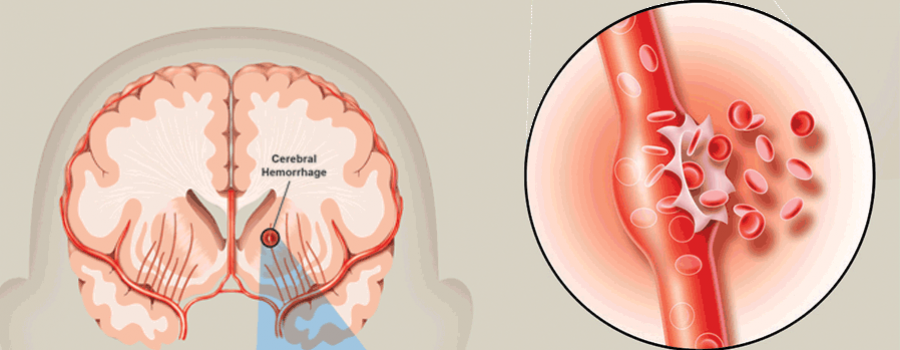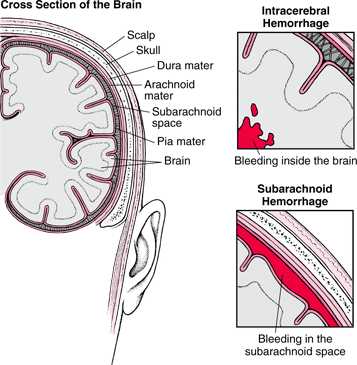Hemorrhagic Stroke Explained


A hemorrhagic stroke is either a ruptured brain aneurysm or a weakened blood vessel leak that suddenly interferes with the brain’s function. Blood spills into or around the brain and creates swelling and pressure, damaging cells and brain tissue. Hemorrhagic strokes account for about 15% of all strokes, and are divided into categories depending on the site and cause of the bleeding. There are two types of hemorrhagic stroke: Intracerebral and Subarachnoid.
Intracerebral hemorrhage – Bleeding occurs from a broken blood vessel within the brain. The bleeding causes brain cells to die and the affected part of the brain stops working correctly. Other kinds of stroke can convert to an intracerebral hemorrhage. For example, a stroke that begins without hemorrhage (a thrombotic or embolic stroke) can lead to intracerebral hemorrhage shortly after.
In rare cases, intracerebral hemorrhage may occur because of a leaking arteriovenous malformation (AVM), which is an abnormal and weak-walled blood vessel that connects an artery and a vein. This week blood vessel is present from birth and is larger than a capillary so blood that flows in can be at a high pressure, eventually causing the AVM to stretch or leak.
Symptoms of an intracerebral hemorrhage almost always occur when the person is awake. They tend to appear without warning, but can also develop gradually. The symptoms worsen over a period of 30 to 90 minutes and can include:
- Sudden weakness
- Paralysis or numbness in any part of the body
- Inability to speak
- Inability to control eye movements correctly
- Vomiting
- Difficulty walking
- Irregular breathing
- Stupor
- Coma
Intracerebral hemorrhage accounts for about 10% of all strokes but has a much higher percentage of deaths due to stroke. Almost half of those who have a large hemorrhage die within a few days. Those who survive usually recover consciousness and some brain function over time. However, most do not recover all lost brain function. Among people 60 and older, intracerebral hemorrhage is more common that subarachnoid hemorrhage.

Subarachnoid hemorrhage – During a hemorrhage, the subarachnoid space is filled with cerebrospinal fluid, causing that space to become bloody. As blood flows into the cerebral spinal fluid, it increases pressure on the brain, resulting in an immediate headache. Most often a subarachnoid hemorrhage happens because of a leaking saccular aneurysm, but it also can occur as the result of a leaking AVM. Almost half of all hospitalized subarachnoid hemorrhage patients die within four weeks, while a significant number of those who survive do so with severe disabilities. Approximately half of the people who have this type of stroke will die before reaching the hospital. A subarachnoid hemorrhage is a life-threatening disorder that can rapidly result in serious, permanent disabilities. This type of stroke is more common among women than men.
People who have a first-degree relative who had a subarachnoid hemorrhage have a higher risk of developing one themselves. Other risk factors include smoking, heavy alcohol use and hypertension (high blood pressure).
Subarachnoid hemorrhages make up about 15% of all strokes, resulting in nearly one quarter of all deaths (approximately 120,000) caused by or related to strokes. Middle aged individuals and females are more likely to be affected.
Between 70-85% of subarachnoid hemorrhage cases are caused by a ruptured cerebral aneurysm. These cases tend to occur in the Circle of Willis and its branches – a circle of arteries that supply blood to the brain.
About 10% of all subarachnoid hemorrhages are caused by arteriovenous malformations. Those with arteriovenous malformations have no symptoms until a hemorrhage occurs.
Prior to rupture, an aneurysm usually causes no symptoms unless it presses on a nerve or leaks small amounts of blood. It is then that warning signs will occur such as:
- Sudden and severe headache (considered to be known as “the worst headache of your life”)
- Facial or eye pain
- Double vision
- Loss of peripheral vision
About 35% of people who reach the hospital alive die soon after. Among those who survivor a bleeding aneurysm, about 50% suffer long-term neurological problems. People who bleed from an aneurysm or AVM and do not have this problem treated are at risk for having a repeat bleed. If the blood vessel is not repaired of removed, one out of five survivors of subarachnoid hemorrhage have bleeding again within 14 days. 50% who do not have surgical treatment will have a repeat bleed within 6 months.

